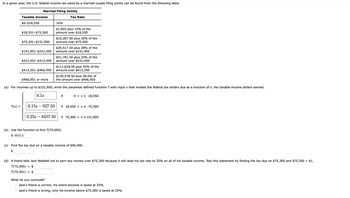
FINANCIAL ACCOUNTING
10th Edition
ISBN: 9781259964947
Author: Libby
Publisher: MCG
expand_more
expand_more
format_list_bulleted
Concept explainers
Question
Please do Parts B, C, D.
thank you.

Transcribed Image Text:In a given year, the U.S. federal income tax owed by a married couple filing jointly can be found from the following table.
Married Filing Jointly
Taxable Income
$0-$18,550
$18,551-$75,300
$151,901-$231,450
$75,301-$151,900 amount over $75,300
$413,351-$466,950
0.1x
10%
$1,855 plus 15% of the
amount over $18,550
T(x) = 0.15x927.50
Tax Rate
$10,367.50 plus 25% of the
$231,451-$413,350 amount over $231,450
0.25x8457.50
$29,517.50 plus 28% of the
amount over $151,900
$51,791.50 plus 33% of the
$130,578.50 plus 39.6% of
$466,951 or more
the amount over $466,950
(a) For incomes up to $151,900, write the piecewise defined function T with input x that models the federal tax dollars due as a function of x, the taxable income dollars earned.
$111,818.50 plus 35% of the
amount over $413,350
if
0 x 18,550
if 18,550 < x≤ 75,300
(b) Use the function to find T(70,000).
$9572.5
if 75,300 < x < 151,900
(c) Find the tax due on a taxable income of $90,000.
$
(d) A friend tells Jack Waddell not to earn any money over $75,300 because it will raise his tax rate to 25% on all of his taxable income. Test this statement by finding the tax due on $75,300 and $75,300 + $1.
T(75,300) = $
T(75,301) $
What do you conclude?
Jack's friend is correct, his entire encome is taxed at 25%.
O Jack's friend is wrong, only his income above $75,300 is taxed at 25%.
Expert Solution
This question has been solved!
Explore an expertly crafted, step-by-step solution for a thorough understanding of key concepts.
This is a popular solution
Trending nowThis is a popular solution!
Step by stepSolved in 5 steps

Knowledge Booster
Learn more about
Need a deep-dive on the concept behind this application? Look no further. Learn more about this topic, accounting and related others by exploring similar questions and additional content below.Similar questions
arrow_back_ios
SEE MORE QUESTIONS
arrow_forward_ios
Recommended textbooks for you

 AccountingAccountingISBN:9781337272094Author:WARREN, Carl S., Reeve, James M., Duchac, Jonathan E.Publisher:Cengage Learning,
AccountingAccountingISBN:9781337272094Author:WARREN, Carl S., Reeve, James M., Duchac, Jonathan E.Publisher:Cengage Learning, Accounting Information SystemsAccountingISBN:9781337619202Author:Hall, James A.Publisher:Cengage Learning,
Accounting Information SystemsAccountingISBN:9781337619202Author:Hall, James A.Publisher:Cengage Learning, Horngren's Cost Accounting: A Managerial Emphasis...AccountingISBN:9780134475585Author:Srikant M. Datar, Madhav V. RajanPublisher:PEARSON
Horngren's Cost Accounting: A Managerial Emphasis...AccountingISBN:9780134475585Author:Srikant M. Datar, Madhav V. RajanPublisher:PEARSON Intermediate AccountingAccountingISBN:9781259722660Author:J. David Spiceland, Mark W. Nelson, Wayne M ThomasPublisher:McGraw-Hill Education
Intermediate AccountingAccountingISBN:9781259722660Author:J. David Spiceland, Mark W. Nelson, Wayne M ThomasPublisher:McGraw-Hill Education Financial and Managerial AccountingAccountingISBN:9781259726705Author:John J Wild, Ken W. Shaw, Barbara Chiappetta Fundamental Accounting PrinciplesPublisher:McGraw-Hill Education
Financial and Managerial AccountingAccountingISBN:9781259726705Author:John J Wild, Ken W. Shaw, Barbara Chiappetta Fundamental Accounting PrinciplesPublisher:McGraw-Hill Education


Accounting
Accounting
ISBN:9781337272094
Author:WARREN, Carl S., Reeve, James M., Duchac, Jonathan E.
Publisher:Cengage Learning,

Accounting Information Systems
Accounting
ISBN:9781337619202
Author:Hall, James A.
Publisher:Cengage Learning,

Horngren's Cost Accounting: A Managerial Emphasis...
Accounting
ISBN:9780134475585
Author:Srikant M. Datar, Madhav V. Rajan
Publisher:PEARSON

Intermediate Accounting
Accounting
ISBN:9781259722660
Author:J. David Spiceland, Mark W. Nelson, Wayne M Thomas
Publisher:McGraw-Hill Education

Financial and Managerial Accounting
Accounting
ISBN:9781259726705
Author:John J Wild, Ken W. Shaw, Barbara Chiappetta Fundamental Accounting Principles
Publisher:McGraw-Hill Education